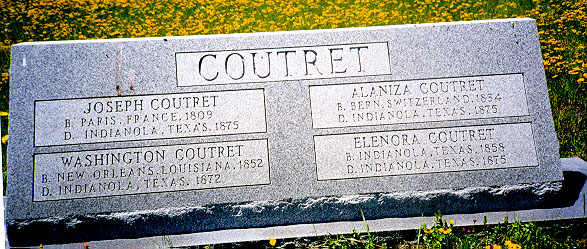
Indianola's Destruction Takes One of Our Families
Alois Julius Coutret, husband of Anne Marie Hargreaves, granddaughter of our HENRY WILLIAM HARGREAVES (via son Israel Hargreaves), lost his parents and all siblings to the hurricane of 1875 that destroyed Indianola, TX.

Photograph by Mario Garcia from a website that no longer exists. But see Indianola Cemetery for another photo, by Gary Ralston.
This storm was the first of two that struck Indianola and is described in a
book Isaac's Storm by Erik Larson (Vintage 2000), 81-83:
"The first storm struck Indianola on September 16, 1875. Gale-force winds had come ashore the previous day and gained velocity throughout the night. By 5:00 P.M. on the sixteenth the wind was blowing at eighty-two miles an hour. The wind continued to strengthen until by midnight, according to Sgt. C. A. Smith, the Signal Corps observer on dusty, "it must have been fully 100 miles an hour."
The storm raised an immense dome of water and shoved it through Indianola, pushing the waters of the Gulf and Matagorda Bay inland "until for 20 miles the back country of prairie was an open sea." Residents fled their homes in boats and gathered in the town's strongest buildings. Shortly after midnight, Smith reported, the tide changed. The survivors believed the worst was over. "This evidence of abatement was hailed with shouts of joy, and was confirmed in a few minutes by the action of the wind, which gradually backed to the north and northwest."
Their joy was premature. The wind again began shoveling water, this time back toward Matagorda Bay, and created an "ebb surge," a mesoscale version of what happens on any beach when water brought ashore by a wave rushes back out to sea, undermining anything in the way. "The tide now swept out toward the bay with terrific force, the wind having but slightly abated, and it was at this time that the greatest destruction to life and property occurred. The buildings remaining had been so loosened and racked by northeast wind and tide that the moment the tremendous force was changed in a cross-direction dozens of them toppled in ruins and were swept into the bay."
The initial storm surge had poured into Matagorda Bay over the course of eighteen hours. It exited in six.
The devastation was stunning. "Fully three-fourths of all the buildings had entirely disappeared from the scene, and of those remaining, a large part were in utter runins," Smith wrote. "Many of those remaining had been swept from their original foundation - some but a few yards, others several blocks."
The storm killed 176 people. ... Gen. Adlphus Greely [head of the Signal Corps], who visited Indianola six months after the storm, estimated the death toll amounted to one-fifth the city's population. The storm left a schooner high and dry five miles inland and killed fifteen thousand sheep and cattle. All this, Greely observed, despite the fact that Indianola occupied a sheltered niche on the Texas coast fourteen miles from the Gulf and behind a broken plume of barrier lands that might have been expected to blunt the force of any oncoming storm. Even six months afterward, the damage was obvious and vivid. The hurricane had destroyed not only the superficial structures made by men, Greely found, but also God's own topography. "The striking physical changes were the formation of a large lake in the rear of the town and the plowing of numerous bayous inland, five connecting across the solid land of an elevation ranging between 10 and 20 feet above the level of Matagorda Bay, on which the town was built. One of these bayous was nearly 20 feet deep at the time of my visit."
Indianola was proud of its port and believed it could be restored to its former propserity. Its residents chose to rebuild. ...
The second hurricane arrived on August 20, 1886 ... The wind raised storm and ebb surges even more destructive than those of 1875 ... The storm caused such thorough destruction, and killed so many residents, the survivors abandoned the town forever."
Larson credits portions of the above to, and quotes from,
Greely, A W, "Hurricanes on the Coast of Texas," National Geographic, Vol 11, No 11, Nov 1900, 442-45
and
Tannehill, Ivan Ray, Hurricanes, Princeton, NJ, Princeton University Press, 1942, 35.
The Indianola Cemetery website lists all the known dead and has photographs of their tombstones. The photo above is from this website, as are the listings of our relatives below:
"Coutret, Alaniza, 1834 - 1875. Born Bern, Switzerland. Died Indianola, Texas.[Modern marker, not included in McCown, 1979]
Coutret, Eleanora, 1858-1875. Born Indianola, Texas. Died Indianola, Texas. [Modern marker, not included in McCown, 1979]
Coutret, Joseph, 1809-1875. Born Paris, France. Died Indianola, Texas 1875. [Modern marker, not included in McCown, 1979]
Coutret, Washington, 1852-1875. Born New Orleans, Louisiana. Died Indianola, Texas. [Modern marker, not included in McCown, 1979]"
The reference McCown, 1979 is the following: McCown, Leonard Joe, Cemeteries of Indianola, Texas: Indianola Cemetery, Cemetery on the Ridge, Zimmerman
Cemetery, Irving, TX, privately printed, 1979.